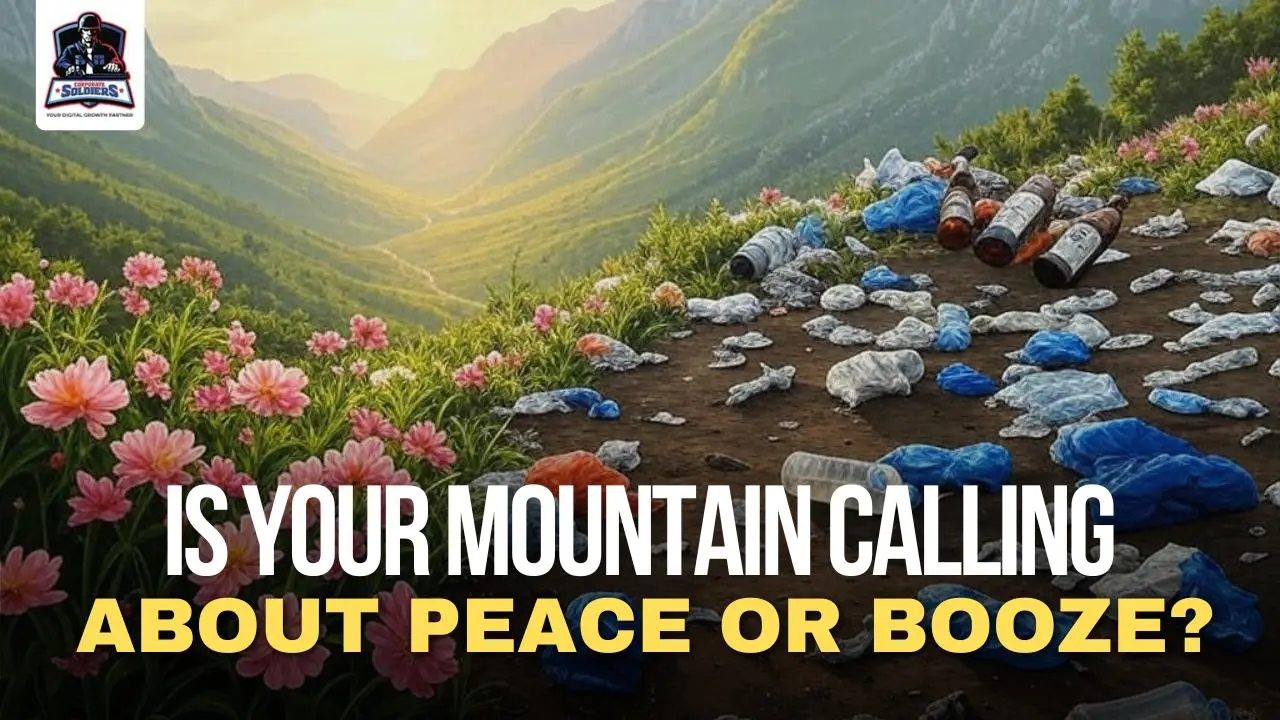Summer vacations are approaching, and roads to the mountains will become a wrestling arena, especially for Uttarakhand and Himachal. With thousands of private vehicles lined up for their dose of mountain air, it will be an infinite queue to find peace in the mountains. Especially on weekends, the itch go to the mountains becomes insatiable among urbanites, isn’t it? But what if this familiar mountain calling becomes the booze-calling adventure? Yes, this situation has been occurring over the years and it is our mountains who are crying for peace now.
Corporate Soldiers feels that these beautiful states are now grappling with a disturbing reality of litter generation through such quick tourism. Also, such irresponsible tourism is threatening its sanctity and natural beauty.
The mountain-calling trend:
When you are immersed in a cut-throat working culture, you long for peace. The stress churns you each day and the solution? Pick your car and drive towards the mountains to ease your prick. But instead of finding peace amongst nature, you are inclined more towards the idea of booze by nature. Readers, are you questioning the sanity of such a quest? Yes, we all should.
Over the recent years, these urbanites, especially those residing in Delhi, Gurugram and NCR, have been following the trend to visit mountains during summer. They all want Instagram-worthy pictures and flaunt their newly sought adventures to the public. There is no harm in visiting these places, but this visit includes tons of garbage such as liquor bottles, chips packets and other trash.
The trend is so widely spread like a disease that it feels incurable. Whether it is our rivers or our mountains, all are crying for their peace. The growing trash mountains of Delhi have reached on its way to sacred mountains and rivers.
Why should we be concerned about this urban tourism?
Earlier, urban tourism to the mountains was meant to escape the summer heat. It used to be a reason why people residing in the plains often flocked to the mountains during the summer reason. But recently the mountains are experiencing an over-surge of such tourism. The reasons are different this time. Now they all want Instagram-worthy pictures, flaunt their ‘coolness factor’ by holding liquor bottles in the backdrop of mountains.
While this over-surge has boosted local economies and tourism industries in states like Himachal Pradesh and Uttarakhand, it has also brought drastic changes to the environment. Their quest for ‘Instagram-worthy’ moments and adventure experiences is leaving behind a trail of garbage, threatening the already fragile mountain ecosystems. The flora and fauna of mountains are mourning over their loss and locals are feeling the same.
Growing Trash Mountains in Mountain Regions, Uttarakhand and Himachal:
Though in this major trail of garbage, liquor bottles and cans have the largest share, the problem extends beyond liquor bottles as this waste disposal includes plastic wrappers and used sanitary products. Mountains are no more about landscapes and spiritual essence but these pristine mountain regions of Uttarakhand and Himachal Pradesh have become regions for waste crisis. The waste that never seems to end and the alarming rise of ‘trash mountains’ have become a threat to biodiversity, and cultural heritage.
We know that tourism is the main economic factor for both states, but the impact this tourism has on the environment is turning hazardous. According to a World Bank report, tourism-related activities in the Indian Himalayan Region usually generate over five million metric tons of waste annually. In this count, Uttarakhand alone contributes around 1,500 tonnes of daily waste during peak seasons.
On the other hand, Himachal Pradesh isn’t any better. The evergreen and popular destination like Manali alone produces 70-100 tonnes of daily garbage. This exceeds its waste treatment capacity of 20-30 tonnes.
What kind of waste is there?
The kind of trash being generated in these mountain regions only indicates one direction. It is the waste from tourist activities. From single-use plastics such as chips packets, water bottles, and other non-biodegradable items, to liquor bottles, this waste dominates the waste composition. The most concerning thing is that despite bans in certain areas like Rishikesh, liquor bottles are frequently being discarded after riverside parties or camping sessions. Also, this waste generation doubles during summer vacations, and pilgrimage seasons such as Char Dham Yatra and other festivals.
The impact is everywhere:
Do you think these problems stay limited to garbage generation? No. The impact can be felt everywhere. This accumulation of waste in such ecologically sensitive regions has its consequences. Let Corporate Soldiers shed light on this!
Water Pollution & Soil Contamination:
The situation of Ganga is no more a hush-hush topic. We all know how we polluted our major rivers like the Ganga in Uttarakhand and Beas in Himachal Pradesh. Not only they are polluted with garbage but include plastic waste and liquor bottles. The aquatic life is under threat and also, this situation is endangering the health of millions who rely on these rivers for drinking water. Also, this open dumping of waste leads to soil contamination which reduces agricultural productivity and harms local flora.
Wildlife & Climate Change:
The animals who are critically endangered such as Himalayan Brown Bear are increasingly scavenging on garbage dumps. This is a concern as it alters their natural diet and behaviour. What is worse than this? Let us tell you. Climate change. Waste burning as a common disposal method in these regions is releasing toxic pollutants such as dioxins and furans. Why are they toxic? Because they contribute to black carbon deposition on glaciers which further accelerates their melting process.
The Current Situation:
See, what our mountains are facing now. Think again whether you love peace or booze.
| Aspect | Uttarakhand | Himachal Pradesh |
| Daily Waste Generation | 1406 TDP (2021-22) | 342-383 TDP (2021-22) |
| Waste Collection Efficiency | 92-100% (Depends yearly) 2022- 92% | 94-100% (2021-22)2022- 94% |
| Waste Treatment Efficiency | 0% treated for several years (Apart from recent progress) | 20-25% treated (2021-22), TDP treated |
| Challenges | No operational large-scaling processing plant | Limited treatment facilities |
| Tourism Impact on Waste | Increase during pilgrimage and summer | Similar as Uttarakhand |
| Measures Taken | Committees formed for waste management | Sanitary landfills and biogas plants formed |
Despite these efforts by local governments and NGOs, we think effective waste management remains elusive due to several factors such as lack of infrastructure and geographical constraints. We know the mountains terrains are difficult for transportation and these constraints make the situation even more alarming. Now think how would you feel if we told you that a 52-foot-high garbage mountain located just 70 meters from the Ganga. Shocked? Well, this is what you are bringing to the mountains and our rivers.
Think Before You Go.
Still thinking of seeking solace in the serene beauty of mountain destinations? We urge you to think once more. Last year, Manali, Shimla, Dharamshala in Himachal Pradesh, and Rishikesh, Nainital, and Mussoorie in Uttarakhand witnessed record-breaking tourist numbers. Not to mention that these numbers invited a lot of garbage dumping in our mountains.
We blame this surge on social media trends that glorify picturesque landscapes and adventure activities such as trekking, rafting, and camping. But we lack civic sense and behaviour which is apparent through liquor bottles, plastic wrappers, and other non-biodegradable trash.
Corporate Soldiers urge all our urban population to take memories and leave only footprints on mountains, not your garbage. It is time we all become responsible towards our climate and follow civic behaviour.










